There are few basic movements in our modern western world that challenge more individuals than the full-depth squat. Arguably the lost human posture of our modern day, the deep squat is fundamental to any comprehensive strength training program, and easy access to this posture is crucial for a comfortable, capable life.
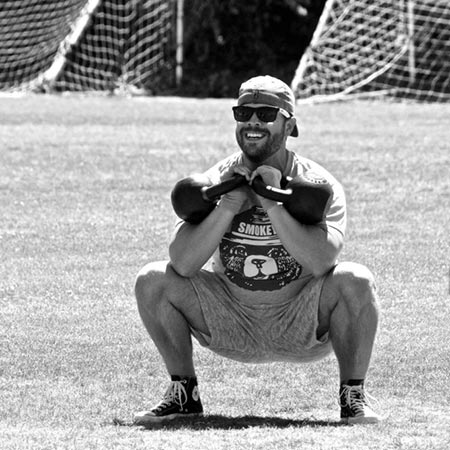
Squatting Past Parallel—Is It Bad for Your Knees?
Despite the bad advice and misunderstandings of some, the deep squat is not hard on your knees. In fact, dropping below parallel is easier on knees than a partial-depth movement[i].The highest forces on your knee joint during a squat occur at 90 degrees, not at full-depth. As you move past this point and into a full-depth position the pressure of your thigh and calf compressing together creates a support for the knee. This is known as the “wrapping effect.” In addition, it is good to keep in mind that joints gain nutrition via loading and movement[ii], and that degeneration of cartilage has been shown to occur due to inactivity[iii] not simply rough activity[iv].
Translation: squat deeply and squat often.
Perhaps avoidance of full-depth squats was perpetuated by well-intentioned but poorly-educated trainers having no other solution when confronted with the stiff and unsteady individuals before them. Provided you have the requisite ankle, knee, and hip flexibility, squatting deep is good for you.
If It’s Difficult, What is the Reason?
You can think of the squat as controlling your body through a vertical motion, to the ground and back. Like anything done well, the squat in its many forms appears deceptively simple, but is often butchered by the adult beginner who may be taking on this movement for the first time since early childhood. Although the squat is just going down to the floor and back, a lot of things can go wrong in that short journey if it has not been walked for some time.
One potential obstacle is that our brain is hard-wired for immediate survival[v]. There aren’t many immediate priorities your brain has within movement, beyond things like “breathe” and “do not injure your face.” As a result, you may reflexively perform all sorts of contortions in order to achieve your intended goal (a “squat”)— the knees may collapse, the heels may rise, and the back may buckle forward or back in order to manage a new and/or difficult load…but you’ll still survive to the next moment!
Those pursuing strength should understand the challenge of moving well under load. There is a body language to strength that is not hardwired in many of us, and often times it will require instruction and training. (Thank you, StrongFirst.)
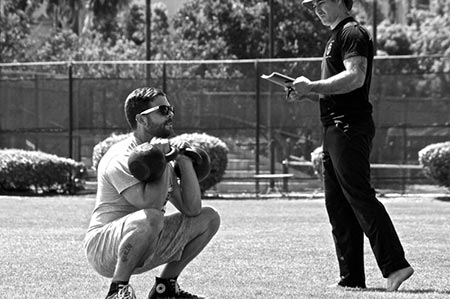
Every movement has a sticking point, and it is at these sticking points where dangerous compensations may occur. With the squat, we tend to get stuck as we approach parallel and the leverage on our hips and knees are the largest.
A common compensation that occurs is that you may pitch excessively forward. For this, StrongFirst offers the face-the-wall drill to help teach you to remain upright while traveling down and back. The drill gives you a physical cue to prevent any excessive forward pitch (the wall is in your way) and can help coach you to and through parallel.
Not everyone exhibits this fault with the squat, however. You may instead be hyperextending your spine, becoming “locked” at a certain depth of the squat. Facing the wall would only exaggerate this compensation, and trying to use it would likely result in no progress. Thus, we need options.
Two Corrections for the Bodyweight Squat:
1: The “back-to-the-wall” drill
For us to stay steady in a squat we need to maintain even weight through our feet as we go down and back. Oftentimes a weight shift at our feet will require a shift or movement up above at our torsos, and so it is crucial the foot remains steady in endeavors of strength. If you have a tendency to pitch to the balls of your feet and cannot keep your heels down during a squat, you probably tend to hyperextend your spine. If you cannot consciously correct this, you may need some feedback to get you beyond this habit.
If you get stuck above parallel in a squat, and the “facing the wall” drill does not coach you past it, try the below back-to-the-wall drill. Your intent should be to resist arching your spine and shifting your weight forward, while focusing on digging (hard) into your heels. This drill is modified from the “Standing Wall Supported Reach” and used with permission from the Postural Restoration Institute®.
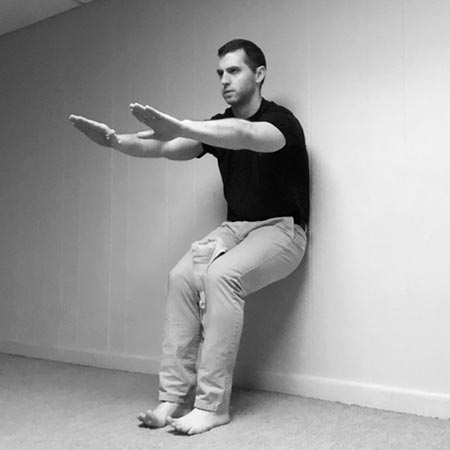
Follow these steps:
- Stand against a wall with your feet 18-24 inches away from the wall (essentially your femur length). Place a rolled-up towel between your knees, and squeeze it throughout this drill.
- Pull yourself down the wall until you feel your quads working hard.
- Dig into your heels and flatten your back from mid-back down, essentially achieving a hollow position at your midsection. Allow your upper back to round as much as necessary to achieve this. Reaching forward with your arms may help.
- Maintain pressure through your heels, with your lower back flat and towel roll being squeezed, while performing 3 power breaths (exhaling with resistance). You should feel your thighs working very hard.
- Perform 3-5 sets of the above sequence. The depth goal for this drill is just short of a 90-degree knee and hip bend. Achieving this will allow your hips and knees to be loaded at the longest point of leverage in the squat, while controlling the position of your pelvis and torso and managing your airflow. Once this is achieved, you should have the fundamentals to break parallel without the tactile aid of the wall behind you.
Do not rush to this depth if the drill is challenging. Like any strength training or drill, the improvements will occur with practice done well.
See video for a visual and verbal explanation:
The “back-to-the-wall” drill allows you to practice sitting into your legs without collapsing or hyperextending your torso, but eventually, you have to get away from the wall and manage gravity independently. Like riding a bike, training wheels are initially useful, but the point is to ultimately not need them.
2: The “kettlebell reach” drill
For many, once they have mastered the above drill, they will be able to move past parallel with a bodyweight squat or a traditional goblet squat. If not, the next drill is for you.
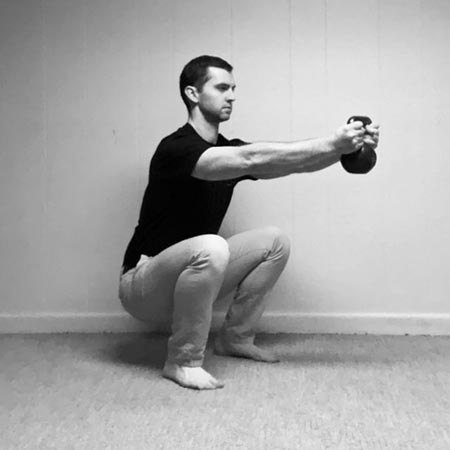
There is a tendency for the kettlebell to shift away from the body as you descend into a goblet squat, but for some the weight may be too great, and the reach not far enough. For help we will use a lighter weight on a longer lever, via the kettlebell reach drill. The back-to-the-wall drill provides a great deal of tactile feedback, but this is never available during any serious strength training pursuits. The individual must learn to perceive and control their body, accurately, using only their feet as a physical reference.
Keep in mind that the weight is intended as a counterweight to guide you past parallel. It is there to make the movement easier, not harder. Choose a light weight, so that it may simply help you balance while moving past parallel.
Be sure to experiment with the width and foot angle of your squat stance to allow for the movement to be full and fluid. Everyone’s squat should be capable of full depth, but not everyone’s squat will look alike. Before you proceed with the following, find your ideal width and angle.
Kettlebell reach video:
Follow these steps:
- Hold a very light kettlebell (8kg for most, maybe 12kg) in the goblet rack position.
- Stand tall with your weight evenly distributed through your feet, both front to back, as well as on the insides and out.
- Inhale at the top, and then exhale slowly as you descend in a controlled manner, pulling yourself down. As you descend, hold the kettlebell out away from your body to provide a counterbalance. The goal is to achieve a full, deep squat without collapsing your trunk, or allowing any shift of weight through your feet.
- Pause for a moment at the bottom and explore what this feels like. Your trunk should be erect, not collapsed or arched, and your feet should have fairly even weight distribution.
- Perform an audible grunt as you push through your feet and stand, pulling the kettlebell back into your chest at the top.
As you get stronger in this squat pattern, you should require less counterbalance—and the traditional goblet squat will be your best choice. Simply up the weight, pull it in close, and enjoy. You will now be able to incorporate full-depth squats in your strength training, and the act of getting to the ground and back will be that much easier in all other parts of your life.
There are many benefits the leisure our modern culture has given us, but the loss of normal human movement is not one of them.
If you cannot squat past parallel, fix it. If you can, train it.
Squat deeply, and squat often. The rest of your life will thank you.
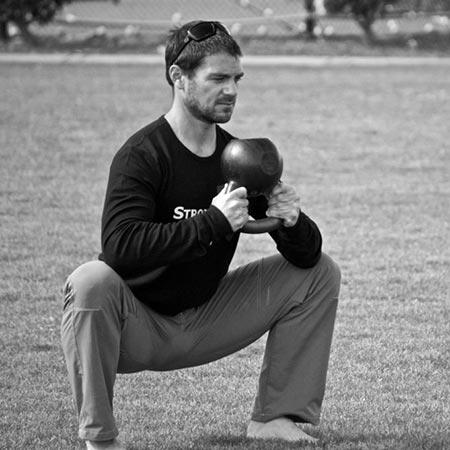
References:
[i]Hartman, H et al “Analysis of the Load on the Knee Joint and Vertebral Column with Changes in Squatting Depth and Weight Load” Sports Med2013 43: 993-1008
[ii]Sophia Fox AJ, et al “The basic science of articular cartilage” Sports Health2009 Nov; 1(6): 461-468
[iii]Buckwalter JA “ Articular cartilage: tissue design and chondrocyte-matrix interactions” Instr Course Lect. 1998; 47: 477-86
[iv]Hunter DJ, Eckstein F “Exercise and osteoarthritis” Journal of Anatomy2009 Feb; 214(2): 197-207
[v]Mobbs, D et al “The ecology of human fear: survival optimization and the nervous system” Frontiers in Neuroscience.2015 9: 55
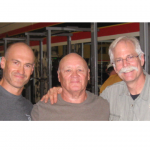
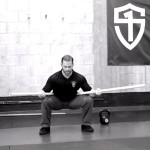
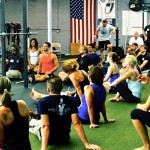
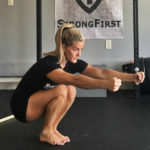

Great article and great timing. A friend of mine visited my gym and he cannot even reach parallel in a body weight squat without elevating his heels by standing on weights or what not. I will pass this article on to him, I think it will help him tremendously.
Very helpful, Noah, thank you very much!
I especially find the second exercise and the breathing suggestions very valuable. Great clear videos too.
Cheers!
Kat
First one looks similar to Egoscue Air Bench, except for the back rounding. You wouldn’t be squeezing your adductor together when squatting, so not sure I see v the point or benefit in that.
Sifter, the wall sit is solely a drill to teach tension at parallel in the squat. Similarly, you would not be leaning against a wall with a squat, but both the wall and towel provide feedback/coaching. It is a common compensation for those that lift off their heels and arch their spine excessively to also roll to the outside of their feet. Squeezing the towel helps prevent this, and at the same time activates some pelvic floor musculature.
Another way to approach your confusion is to simply try the drill on a day that your squat feels stiff and difficult, and see how your squat feels afterwards.